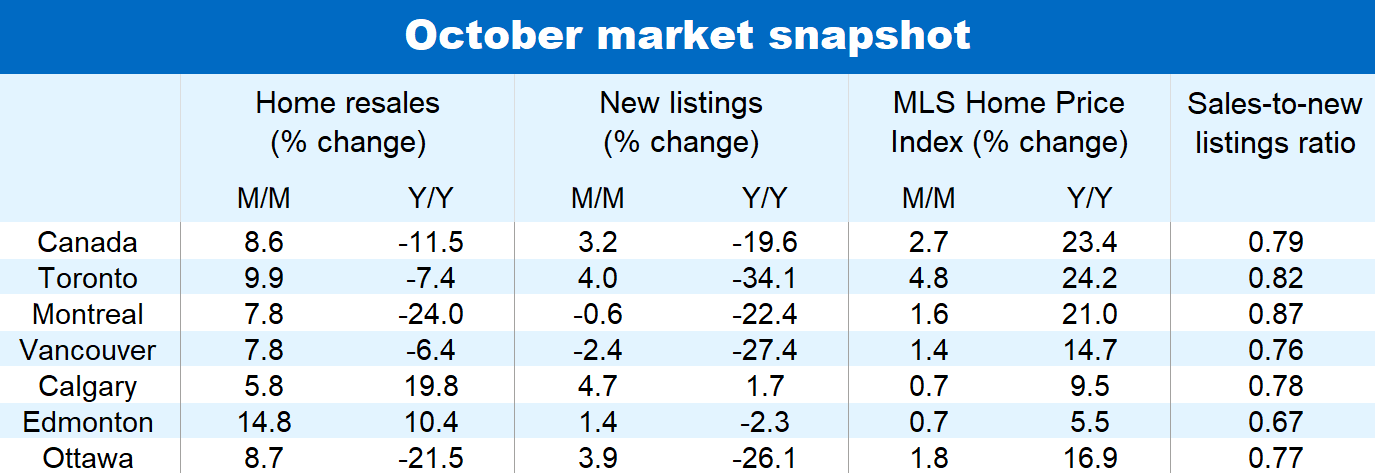It didn’t take much of a rise in new listings to get home buyers going last month. Just 3.2% to be exact. In a market starved of inventories, a 3.2% m/m increase was a rare opportunity for many to take the plunge. It was also grossly insufficient to meet the huge demand out there. Perhaps realizing the fall season may not deliver hoped-for housing answers, other buyers opted to dig deeper into (very thin) existing inventories. In the end, Canadian home resales jumped a solid 8.6% from September, making it the second-strongest October on record—and the clearest evidence yet the summer’s cooling period has stalled.
Home prices ramping up again
For this to happen, though, successful buyers had to dig deeper into their purchasing budget to beat the competition. They upped the ante in bidding wars across the country, setting prices on a faster track—marking a departure from the moderation we saw through the summer. Canada’s composite MLS Home Price Index posted the fastest monthly increase (2.7%) in seven months, coming just short of the 2.9% gains recorded in February and March. Upward price pressure especially intensified in the Toronto area (up 4.8% m/m) where condo apartment values are now going up rapidly.

Widespread increases in Ontario
Several other Ontario markets recorded significant price advances in October, including North Bay (up 4.9% m/m), Cambridge (up 4.2%), Barrie (up 3.3%), Hamilton (up 3.0%) and Kitchener-Waterloo (up 3.0%). All continue to heavily favour sellers amid strong demand and historically low inventories. The increase in home resales was widespread across local markets in the province, indicating buyer interest in smaller markets has yet to wane.
Sellers reign supreme in Quebec
A similar situation prevailed in Quebec where resales jumped 7.6% m/m and prices re-accelerated province-wide. Sellers generally reign supreme with inventories at, or near historical lows, and loads of buyers still eager (and increasingly desperate) to land deals. Both Montreal and Quebec City recorded stronger price gains relative to September—-halting at least temporarily the cooling trend that emerged this summer.
Generally solid activity in Atlantic Canada…
Activity was solid overall in most Atlantic Canada though resales came down a notch in Nova Scotia alongside a further decline in new listings. Not many new sellers have come to market in recent months in Halifax, which has made things more challenging for buyers. We’ve seen a steadier flow of properties listed for sale in New Brunswick, however, allowing resales to rise materially in the past three months. Sellers in that province may be enticed by some of the bigger price increases in the country over the past year.
…and Western Canada
Despite scarce inventories posing an obstacle, all four Western provinces recorded higher home resales in October. Winnipeg (up 15.1% m/m), Edmonton (up 14.8%), Saskatoon (up 10.6%) and Regina (up 9.4%) saw significant increases. Prices escalated further in most markets, led by the Fraser Valley (MLS HPI up 2.6% m/m), Vancouver (up 1.4%), Saskatoon (up 0.8%), Edmonton (up 0.7%) and Calgary (up 0.7%). Exceptionally tight demand-supply conditions will support rising price trends in the near term.
Market head fake?
We’re unconvinced the more vigorous activity and price gains marks a change in direction for the market. We suspect it reflects a temporary uptick in demand driven by buyers rushing to land deals before interest rates rise. Our view remains that deteriorating affordability (arising from soaring prices or higher interest rates, or both) and easing pandemic restrictions will gradually cool demand over the coming year. We expect extremely tight demand-supply conditions will keep prices under intense upward pressure in the near term though see such pressure easing significantly by the second half of 2022 as markets achieve a better balance.

See PDF with complete charts
This article is intended as general information only and is not to be relied upon as constituting legal, financial or other professional advice. The reader is solely liable for any use of the information contained in this document and Royal Bank of Canada (“RBC”) nor any of its affiliates nor any of their respective directors, officers, employees or agents shall be held responsible for any direct or indirect damages arising from the use of this document by the reader. A professional advisor should be consulted regarding your specific situation. Information presented is believed to be factual and up-to-date but we do not guarantee its accuracy and it should not be regarded as a complete analysis of the subjects discussed. All expressions of opinion reflect the judgment of the authors as of the date of publication and are subject to change. No endorsement of any third parties or their advice, opinions, information, products or services is expressly given or implied by Royal Bank of Canada or any of its affiliates. This document may contain forward-looking statements within the meaning of certain securities laws, which are subject to RBC’s caution regarding forward- looking statements. ESG (including climate) metrics, data and other information contained on this website are or may be based on assumptions, estimates and judgements. For cautionary statements relating to the information on this website, refer to the “Caution regarding forward-looking statements” and the “Important notice regarding this document” sections in our latest climate report or sustainability report, available at: https://www.rbc.com/community-social- impact/reporting-performance/index.html. Except as required by law, none of RBC nor any of its affiliates undertake to update any information in this document.


